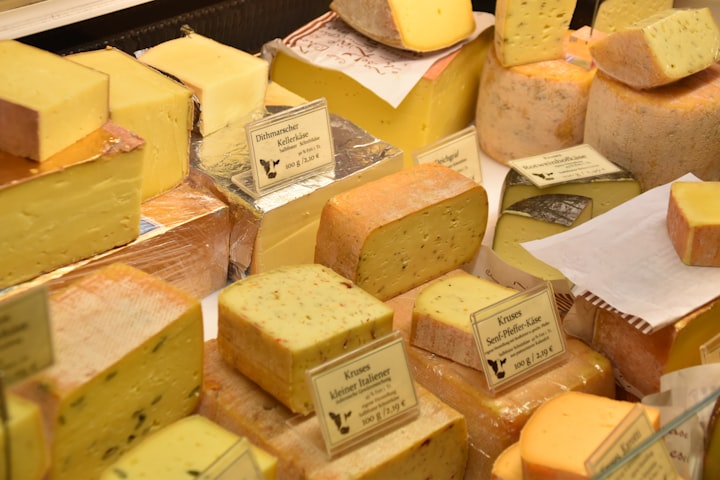earlier than empires and royalty,
before pottery and writing,
earlier than steel equipment and guns –
there was cheese.
As early as 8000 BCE,
the earliest Neolithic farmers residing inside the Fertile Crescent
started out a legacy of cheesemaking
almost as antique as civilization itself.
The upward thrust of agriculture led to domesticated sheep and goats,
which historical farmers harvested for milk.
but while left in warm situations for numerous hours,
that clean milk commenced to bitter.
Its lactic acids induced proteins to coagulate, binding into soft clumps.
Upon coming across this ordinary transformation,
the farmers tired the remaining liquid –
later named whey –
and determined the yellowish globs could be eaten clean as a smooth, spreadable meal.
these clumps, or curds, became the building blocks of cheese,
which might sooner or later be aged, pressed, ripened, and whizzed
into a diverse cornucopia of dairy delights.
the invention of cheese gave Neolithic human beings an huge survival gain.
Milk became rich with important proteins, fat, and minerals.
but it also contained excessive portions of lactose –
a sugar which is hard to procedure for plenty historic and present day stomachs.
Cheese, but, should provide all of milk’s advantages with an awful lot less lactose.
And for the reason that it could be preserved and stockpiled,
those essential nutrients will be eaten
during scarce famines and long winters.
some seventh millennium BCE pottery fragments discovered in Turkey
nonetheless contain telltale residues of the cheese and butter they held.
by using the stop of the Bronze Age,
cheese become a widespread commodity in maritime trade
for the duration of the eastern Mediterranean.
within the densely populated town-states of Mesopotamia,
cheese became a staple of culinary and religious life.
a number of the earliest recognized writing
consists of administrative data of cheese quotas,
listing a spread of cheeses for unique rituals and populations
across Mesopotamia.
facts from close by civilizations in Turkey additionally reference rennet.
This animal byproduct, produced within the stomachs of certain mammals,
can boost up and manipulate coagulation.
sooner or later this state-of-the-art cheesemaking tool spread around the globe,
giving manner to a wide range of latest, more difficult cheeses.
And even though some conservative food cultures rejected the dairy delicacy,
many more embraced cheese, and quick brought their very own neighborhood flavors.
Nomadic Mongolians used yaks’ milk to create hard, sundried wedges of Byaslag.
Egyptians loved goats’ milk cottage cheese, straining the whey with reed mats.
In South Asia, milk was coagulated with a spread of meals acids,
such as lemon juice, vinegar, or yogurt
after which hung to dry into loafs of paneer.
This gentle slight cheese could be brought to curries and sauces,
or simply fried as a quick vegetarian dish.
The Greeks produced bricks of salty brined feta cheese,
alongside a harder variety similar to nowadays’s pecorino romano.
This grating cheese changed into produced in Sicily
and utilized in dishes all throughout the Mediterranean.
underneath Roman rule, “dry cheese” or “caseus aridus,”
have become an essential ration
for the nearly 500,000 soldiers guarding the great borders of the Roman Empire.
And whilst the Western Roman Empire collapsed,
cheesemaking endured to adapt
inside the manors that dotted the medieval ecu geographical region.
within the hundreds of Benedictine monasteries scattered across Europe,
medieval clergymen experimented with no end in sight with different kinds of milk,
cheesemaking practices,
and aging tactics that caused lots of today’s popular cheeses.
Parmesan, Roquefort, Munster and several Swiss kinds
have been all subtle and perfected through those cheesemaking clergymen.
within the Alps, Swiss cheesemaking became particularly successful –
producing a myriad of cow’s milk cheeses.
by way of the stop of the 14th century,
Alpine cheese from the Gruyere location of Switzerland had turn out to be so profitable
that a neighboring kingdom invaded the Gruyere highlands
to take manipulate of the growing cheese alternate.
Cheese remained famous via the Renaissance,
and the industrial Revolution took manufacturing out of the monastery
and into machinery.
these days, the sector produces roughly 22 billion kilograms of cheese a year,
shipped and fed on around the world.
but 10,000 years after its invention,
neighborhood farms are nevertheless following inside the footsteps of their Neolithic ancestors,
hand crafting one of humanity’s oldest and favorite meals.






Comments
There are no comments for this story
Be the first to respond and start the conversation.